
Counteroffensive in Kursk region: Russia's goals, Ukraine’s strategy in Horlivka sector. Serhiy Zgurets' column
Since September 10, Russian troops have been conducting large-scale offensives to try to drive the Ukrainian army from positions important to Russia
Operation in the Kursk region
President Volodymyr Zelenskyy said that the Russians had launched a counteroffensive, and that it was according to Ukraine's plan. Foreign experts conclude that Russian troops continued to counterattack along the entire Ukrainian ledge in the Kursk region, but achieved only minor success.
On the left flank of Ukraine's Kursk bridgehead, the Russian troops attacked from Korenevo to Snagost, right along the road, and to Snagost from the blocked Seim River in the Glushkovsky district, where, despite the destruction of Russian crossings and pontoons, they still managed to amass a certain number of personnel and launch attacks from the west toward Ukrainian flanks. The Russians attacked on the left flank with the most combat-ready formations that had been redeployed from other areas. First of all, it was the 115th Marine Brigade, in its almost entirety, and two parachute regiments of the 109th Airborne Division.
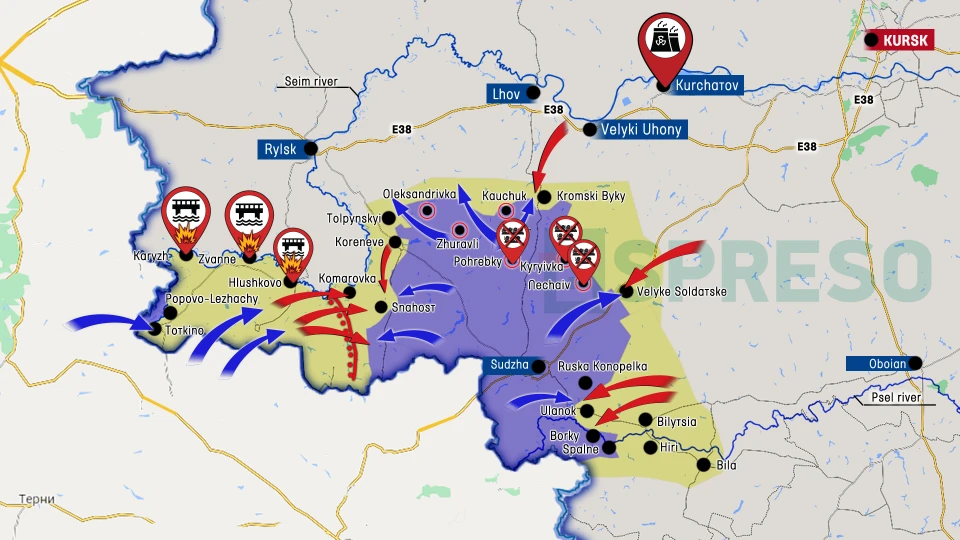
Russia had two goals: first, to push Ukrainian troops further away from Korenevo to create a land corridor to unblock Russian forces in the Glushkovsky area, a 20-by-40-kilometer trap. Russia's second goal was to move beyond Snagost to the state border to complicate the Ukrainian Armed Forces' logistics. They wanted to break through to the Korenevo-Sudzha highway, and Ukraine's main logistical artery to supply the entire bridgehead is actually the Suzha-Sumy highway.
The attack from the north of Korenevo was with a certain amount of armored vehicles. Russia broke through the defense of the 103rd Territorial Defense Brigade, forcing several units to retreat. Apparently, the village of Snagost is now under Russia's control or in the gray zone. There is also a video showing the presence of Russians in Vishnevka and another settlement near Korenevo, which are affecting the unblocking of the Glushkovsky district. This is all that is known about Russia's advance. There are about 10-12 different videos, and they are not enough to assess the dynamics in other areas. However, it is important that the Armed Forces began preemptive actions, because for two days it was reported that Ukrainian troops had entered the Kursk region, but in new areas, a little further west of the Russian offensive line.
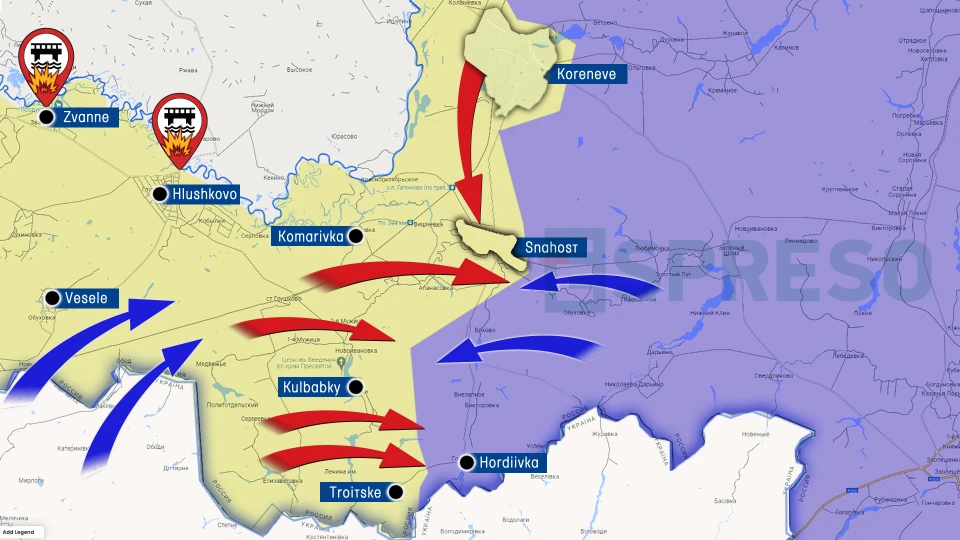
Currently, the offensive is taking place in the area of Novyi Put with the advance towards Veseloye. This is to the west of the area where the Russian enemy was actively attacking just a few days ago. This is an outflanking of the Russian units in the Glushkovsky district. Advancing a few kilometers in this direction will force the Russian army to ease its pressure to the east. The situation looks quite dynamic, and if Putin has indeed set a deadline of October 1 for the withdrawal of the Armed Forces from the Kursk region, we can expect further Russian assaults with the corresponding level of losses. On the part of Ukraine, it is necessary to assess all prospects, using the means, forces and reserves to destroy Russia and hold the positions. British Defense Secretary John Healey said that the longer Ukrainian troops hold their positions in the Kursk region, the weaker Putin becomes. Volodymyr Zelenskyy has also repeatedly stated that holding this foothold is one of the elements of the peace plan. So in any case, this will influence the approaches of Ukrainian military leadership.
Pokrovsk-Kurakhove direction
The Pokrovsk-Kurakhove section of the frontline is the most difficult. According to the Ukrainian Armed Forces General Staff, 100 combat clashes took place there over the past day, out of 143 along the entire frontline. Actually, Russia is not advancing towards Pokrovsk. Russia has focused its main efforts south of Selydove and bypassing it. In the direction of Selydove, the frontline itself remains stable with the reinforcement of Ukrainian units. However, there are risks of attacks from north of Marynivka on Selydove.
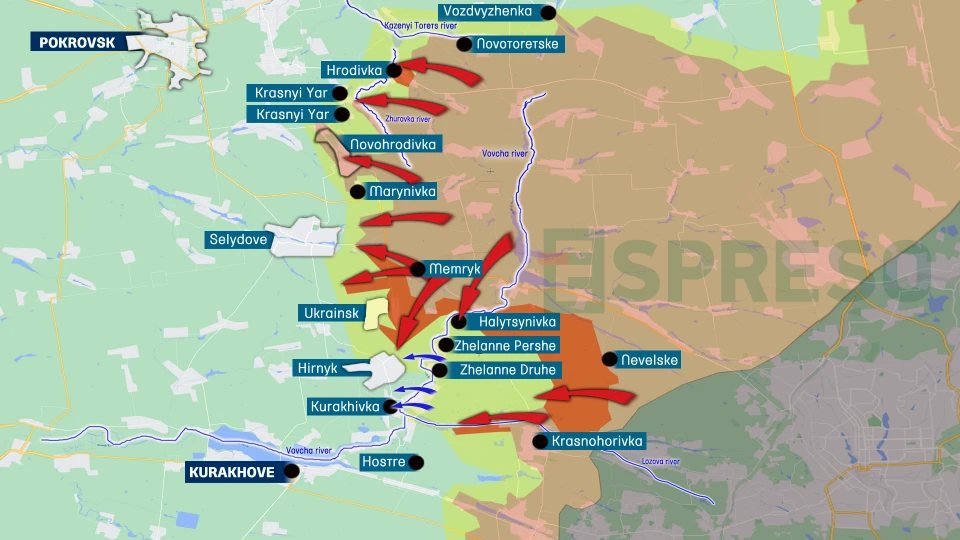
In fact, the main risks are that Russia is trying to carry out offensive actions aimed at surrounding or blocking the Ukrainian Armed Forces, which are located in the bridgehead west of Nevelske. We are talking about a triangle, relatively speaking - Halytsynivka, Nevelske, Krasnohorivka. The planned withdrawal of Ukrainian troops is underway there, while the Russian enemy is trying to attack east of Krasnohorivka, in particular in the village of Hostre.
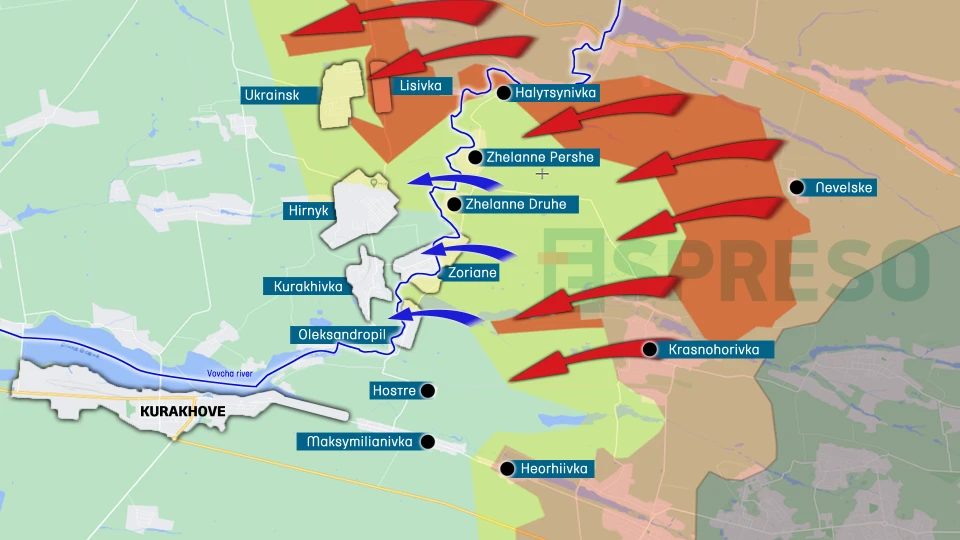
Yesterday, there was a video from the 46th Airmobile Brigade showing the Russian troops launching a large-scale attack using 46 armored vehicles, tanks, infantry fighting vehicles and motorcycles.
This attack started in the morning. There were four waves of attack, and it ended around noon. At least 15 units of Russian offensive vehicles were destroyed out of 46 pieces of equipment. The attack was thwarted, which confirms the high skill of the 46th Airmobile Brigade. However, we understand that these attacks are quite frequent, and this suggests that Russia is concentrating its forces in these areas to the maximum extent possible to achieve a breakthrough in Ukraine's defense.
The situation is the same in other parts of the frontline, particularly in the Toretsk sector. The dynamics of hostilities in the Toretsk sector seem to have calmed down to some extent, but this does not make it any less dangerous.
Situation in the Horlivka sector
Russia captured certain positions, after which Ukrainian units were redeployed. Thanks to the work of the 12th Special Forces Brigade in this area, the adversary was repelled from several positions. Today the General Staff reported six attacks in the Toretsk area in different directions.
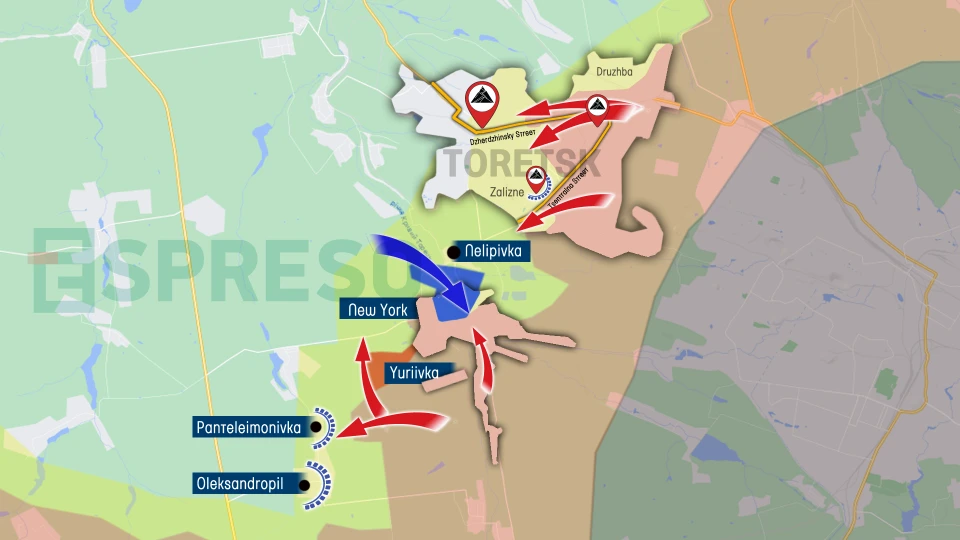
Yevhen Iievliev, a soldier of the Ukrainian Armed Forces who is fighting with his units in the Toretsk sector, spoke about the dynamics of the fighting. This area has been extremely difficult for some time. Russia is using all the accumulated forces and means to advance through the agglomeration in small assault groups to push the Ukrainian defense. However, it is not succeeding.
“I have repeatedly heard and read on Telegram channels that the enemy has reduced its activity. There was a certain decrease in activity, but this is most likely due to the regrouping of troops. To date, they have not given up trying to attack and storm our positions. Indeed, they managed to liberate part of northern New York. There is a village of Lypivka near New York where the guys have done a very good job, and there are high hopes that they will continue to work. But it is in our direction, which is now trendy to call Toretsk, but in fact it is the Horlivka direction, that the enemy keeps trying to storm our positions in small groups. These are not mechanized assaults like you showed with 47 pieces of equipment, because the positions here are much more fortified and stronger than the positions in the direction of Pokrovsk, where the front is not fixed and not established. It is much easier to make mechanized assaults there. The enemy is trying to come in groups of 7-12 people at night and day, supervising it all from the sky. They are trying to storm and take away our positions, moving towards Panteleimonivka. Despite the loss of some positions and square kilometers of Ukrainian land over the past month, the front line is more or less fixed. The enemy is being repelled and thrown back, but the occupiers do not give up their attempts to storm the line,” said Iievliev.
Tactics of countering the Russian troops
Commenting on the interaction between the units of the Ukrainian Armed Forces during Russian assaults, the serviceman noted that in practice it happens in different ways: “I have to say that everything works as written in a military science textbook, but in practice it does not always happen that way. It all depends on the adequacy of the incoming units' command. I know of cases during this war when a unit entered, stood next to its neighbors, and communication between them was established only after a month. That is, for a month the guys stood side by side and talked to each other at their positions, but the command had not yet established any connections. There were such cases. But frankly speaking, today everyone is more or less trained, and platoon and company teams entering the line establish horizontal communications, which solves a lot of things. That is, we don't have something, but they do, and we can exchange it. You can transfer some data through operational headquarters, of course, everything is done according to the protocol, but sometimes it is much faster, either by radio or via WhatsApp, if you have Starlink, you can ask the guys from the neighboring units to light up with reconnaissance drones, and so on. Sometimes horizontal communication works much faster than vertical up and down. Therefore, these are very individual cases. There are units that you meet as a breath of fresh air, and sometimes it is a little different.”
Thus, the situation at the railroad is related to improving the efficiency of interaction between units. Even in this area, we sometimes encounter units where interaction at the horizontal level is established faster than between commanders. This is not entirely good, because effective interaction at the command level creates synergy to strengthen the capabilities of all units together. We hope that this section of the front, like the others, will have enough artillery to destroy the enemy. The statistics of comparison with Russia's artillery is getting better. Previously, the ratio of artillery strikes was 1 to 10, and now, according to General Syrskyi, Ukraine has a ratio of 1 to 2 or 1 to 3. This is a good indicator, but it is necessary to strive for more.
Ukraine relies on the help of its partners. Today and tomorrow, negotiations will continue between the American and British leaderships to allow the use of long-range weapons systems deep into Russian territory. This includes the use of ATACMS, Storm Shadow, SCALP, which provide a range of 300 kilometers to destroy the Russian enemy. This is not a silver bullet that changes everything at once, but it is a component that must be used to its full potential, just as Ukrainian military do when they hold the line in all the most difficult areas of the front.
- News











































